50 Gb/s Electro-Absorption Modulator Integrated with a Distributed Feedback Laser for Passive Optical Network Systems
Abstract
1. Introduction
2. Device Fabrication
3. Experimental Setup and Results
4. Discussion
5. Conclusions
Author Contributions
Funding
Institutional Review Board Statement
Informed Consent Statement
Data Availability Statement
Conflicts of Interest
References
- Tartaglia, A.; Magri, R.; Deho, A. Optical solutions for 5G: Technologies and network architectures. In Proceedings of the 21st International Conference on Transparent Optical Networks, Angers, France, 9–13 July 2019. [Google Scholar]
- Zhang, D.; Nesset, D.; Liu, D. 50 Gbps Passive Optical Network (50G-PON) for Broadband Access and Beyond [Invited]. In Proceedings of the 2022 27th OptoElectronics and Communications Conference (OECC), Toyama, Japan, 3–6 July 2022. [Google Scholar]
- Zhang, D.; Zhe, D.; Jiang, M.; Zhang, J. High speed WDM-PON technology for 5G fronthaul network. In Proceedings of the 2018 Asia Communications and Photonics Conference, Hangzhou, China, 26–29 October 2018; p. 8596261. [Google Scholar]
- Borkowski, R.; Schmuck, H.; Cerulo, G.; Provost, J.; Houtsma, V.; Van Veen, D.; Harstead, E.; Mallecot, F.; Bonk, R. The impact of transmitter chirp parameter on the power penalty and design of 50 Gbit/s TDM-PON. In Proceedings of the 2020 Optical Fiber Communications Conference and Exhibition, San Diego, CA, USA, 8–12 March 2020. [Google Scholar]
- Rosales, R.; Cano, I.; Nesset, D.; Ye, Z.; Brenot, R.; Dubrovina, N.; Durán-Valdeiglesias, E.; Debrégeas, H.; Carrara, D.; Lelarge, F. First Demonstration of an E2 Class Downstream Link for 50 Gb/s PON at 1342 nm. In Proceedings of the 2020 European Conference on Optical Communications, Brussels, Belgium, 6–10 December 2020; p. 9333394. [Google Scholar]
- Zhang, D.; Liu, D.; Wu, X.; Nesset, D. Progress of ITU-T higher speed passive optical network (50G-PON) standardization. J. Opt. Commun. Netw. 2020, 12, D99–D108. [Google Scholar] [CrossRef]
- Moeneclaey, B.; Blache, F.; Van Kerrebrouck, J.; Brenot, R.; Coudyzer, G.; Achouche, M.; Qiu, X.; Bauwelinck, J.; Yin, X. 40-Gb/s TDM-PON Downstream Link with Low-Cost EML Transmitter and APD-Based Electrical Duobinary Receiver. J. LiLightwave Technol. 2017, 35, 1083–1089. [Google Scholar] [CrossRef]
- Rosales, R.; Cano, I.; Nesset, D.; Brenot, R.; Talli, G. 50G-PON Downstream Link up to 40 km with a 1342 nm Integrated EML+SOA. IEEE Photonics Technol. Lett. 2022, 34, 306–308. [Google Scholar] [CrossRef]
- Zhou, D.; Wang, H.; Zhang, R.; Wang, B.; Bian, J.; An, X.; Lu, D.; Zhao, L.; Zhu, H.; Ji, C. Fabrication of 32Gb/s Electroabsorption Modulated Distributed Feedback Lasers by Selective Area Growth Technology. Chin. Phys. Lett. 2015, 32, 054205. [Google Scholar] [CrossRef]
- Mino, L.; Agostino, A.; Codato, S.; Martinez-Criado, G.; Lamberti, C. Effect of selective area growth mask width on multi-quantum-well electroabsorption modulated lasers investigated by synchrotron radiation X-ray microprobe. Nucl. Instrum. Methods Phys. Res. Sect. B. 2012, 284, 6–9. [Google Scholar] [CrossRef]
- Al-Moathin, A.; Watson, S.; Tang, S.; Ye, S.; Di Gaetano, E.; Raghib Ali Al-Taai, Q.; Eddie, I.; Huang, Y.; Zhang, R.; Li, C.; et al. EML Based on Identical Epitaxial Layer, Side-Wall Grating and HSQ Planarization. IEEE Photonics Tech. Lett. 2022, 34, 317–320. [Google Scholar] [CrossRef]
- Deng, Q.; Guo, L.; Liang, S.; Sun, S.; Xie, X.; Zhu, H.; Wang, W. AlGaInAs EML having high extinction ratios fabricated by identical epitaxial layer technique. Opt. Commun. 2018, 413, 54–57. [Google Scholar] [CrossRef]
- Han, L.; Liang, S.; Zhu, H.; Zhang, C.; Wang, W. Fabrication of an electro-absorption modulated distributed feedback laser by quantum well intermixing with etching ion-implantation buffer layer. Chin. Opt. Lett. 2015, 13, 081301. [Google Scholar]
- Han, L.; Liang, S.; Zhu, H.; Zhang, C.; Wang, W. 1.53μ m EML Fabricated by Ion-Implantation Induced QWI with Etching Implant Buffer Layer. In Proceedings of the Asia Communication and Photonics Conference, Beijing, China, 12–15 November 2013. [Google Scholar]
- Nakai, Y.; Nakanishi, A.; Yamaguchi, Y.; Yamauchi, S.; Nakamura, A.; Asakura, H.; Takita, H.; Hayakawa, S.; Mitaki, M.; Sakuma, Y.; et al. Uncooled operation of 53-GBd PAM4 (106-Gb/s) EA/DFB lasers with extremely low drive voltage with 0.9 Vpp. J. Lightwave Technol. 2019, 37, 1658–1662. [Google Scholar] [CrossRef]
- Kobayashi, W.; Arai, M.; Yamanaka, T.; Fujiwara, N.; Fujisawa, T.; Tadokoro, T.; Tsuzuki, K.; Kondo, Y.; Kano, F. Design and fabrication of 10-/40-Gb/s, uncooled electroabsorption modulator integrated DFB laser with butt-joint structure. J. Lightwave Technol. 2010, 28, 164–171. [Google Scholar] [CrossRef]
- Hayashi, H.; Makino, S.; Kitatani, T.; Shinoda, K.; Tanaka, S.; Sasada, N.; Naoe, K. 2011. Uncooled 43-Gb/s InGaAlAs light source for 10-km transmission. IEEE Photonics Technol. Lett. 2011, 23, 441–443. [Google Scholar] [CrossRef]
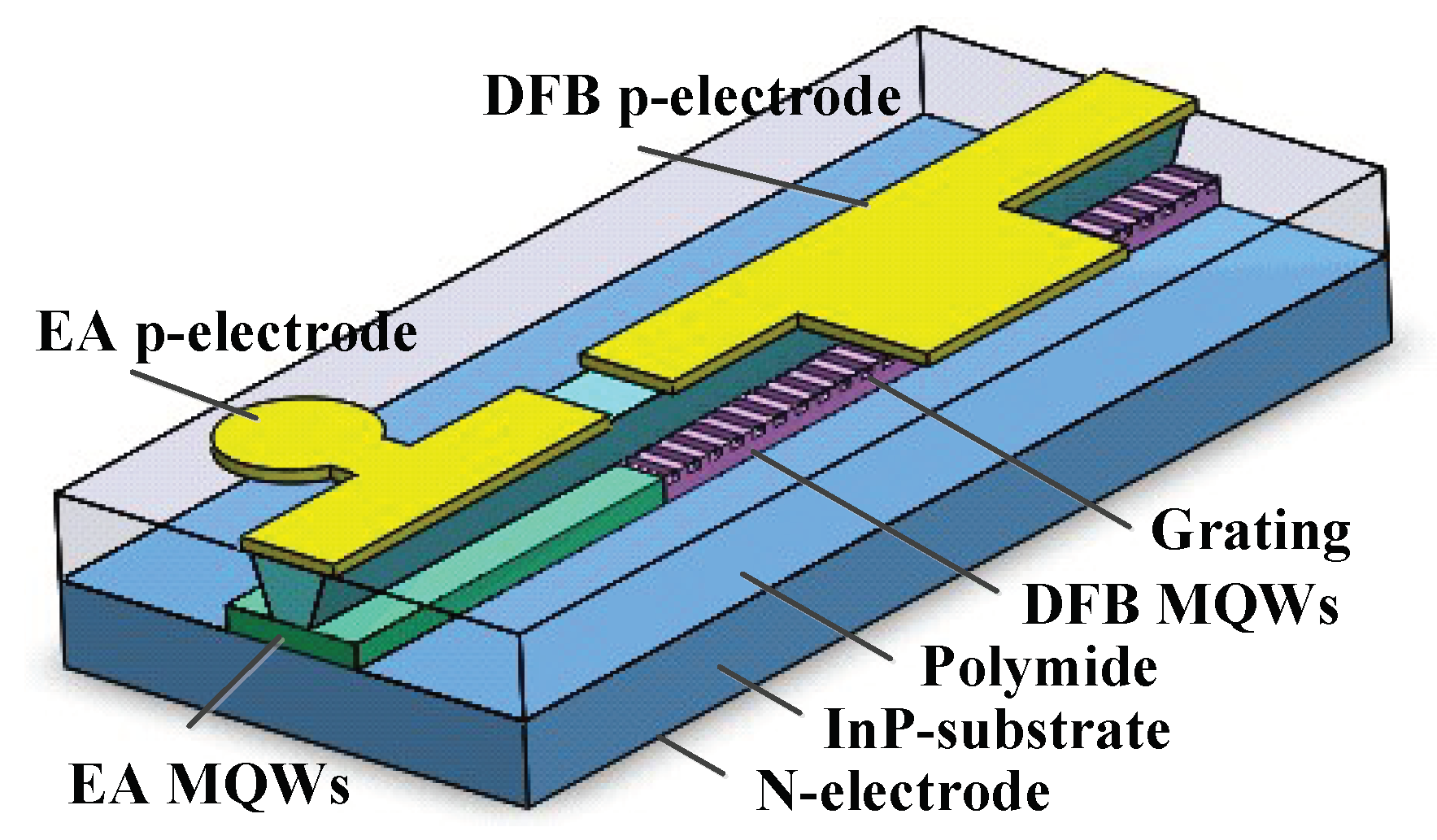

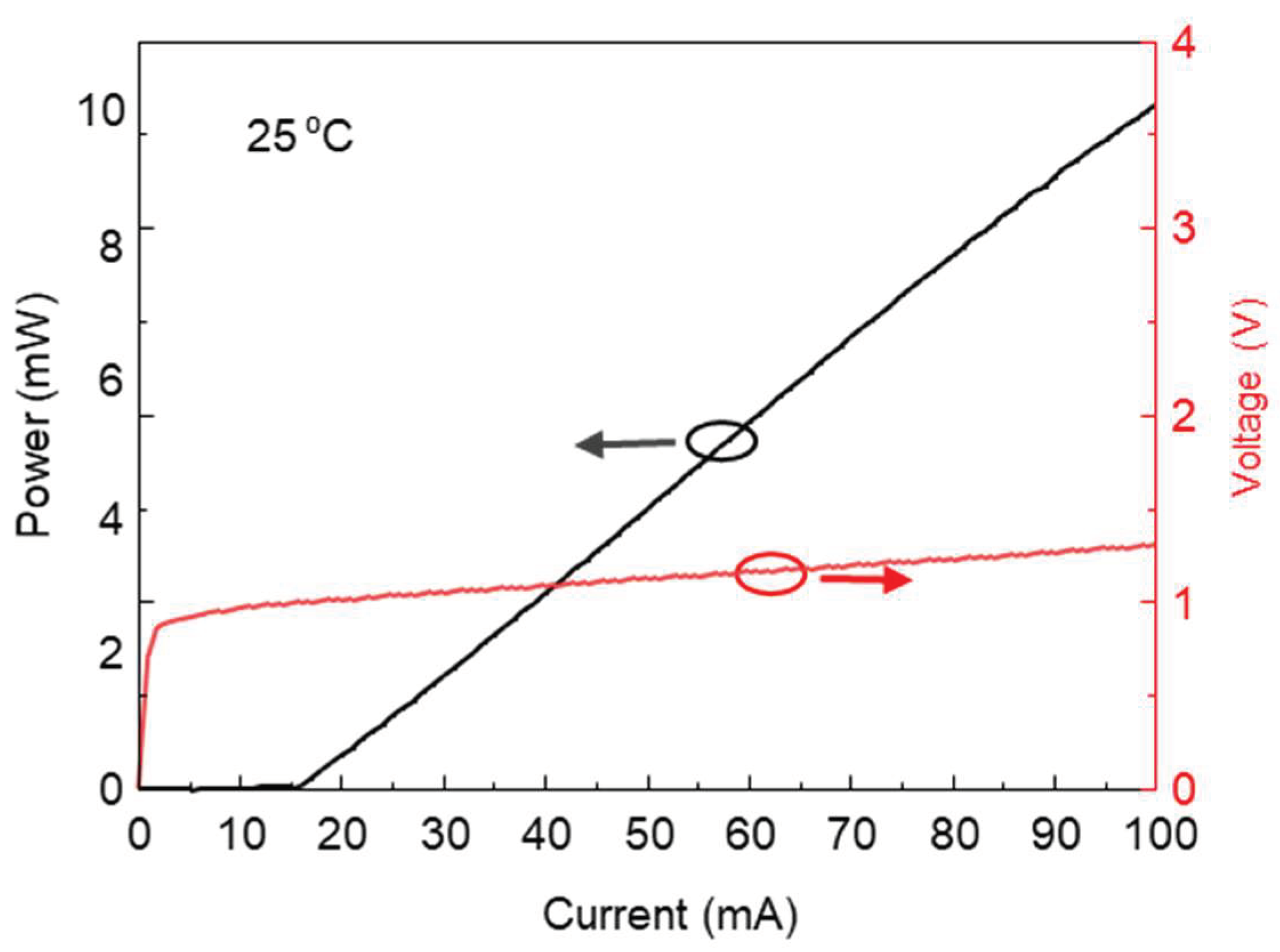
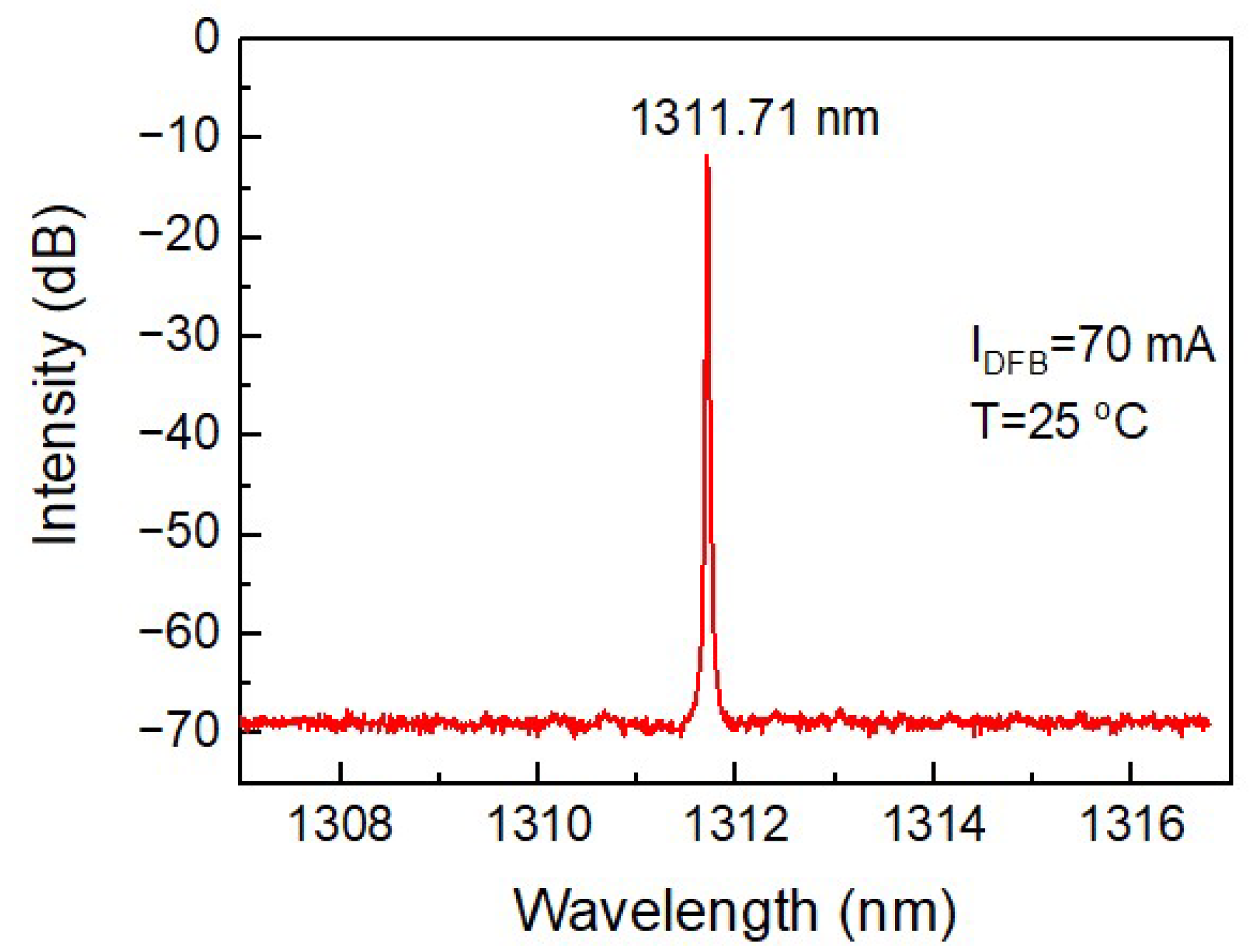
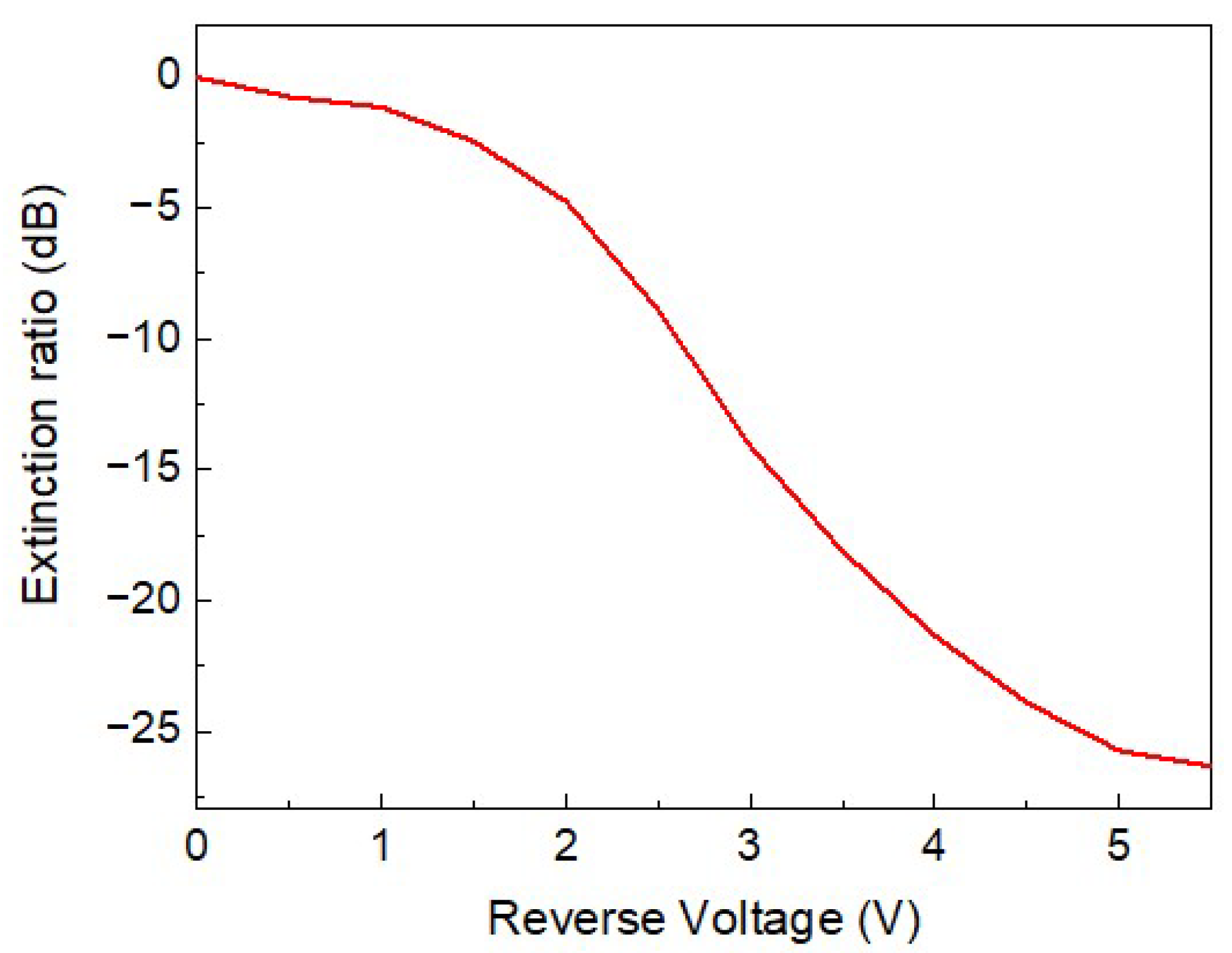
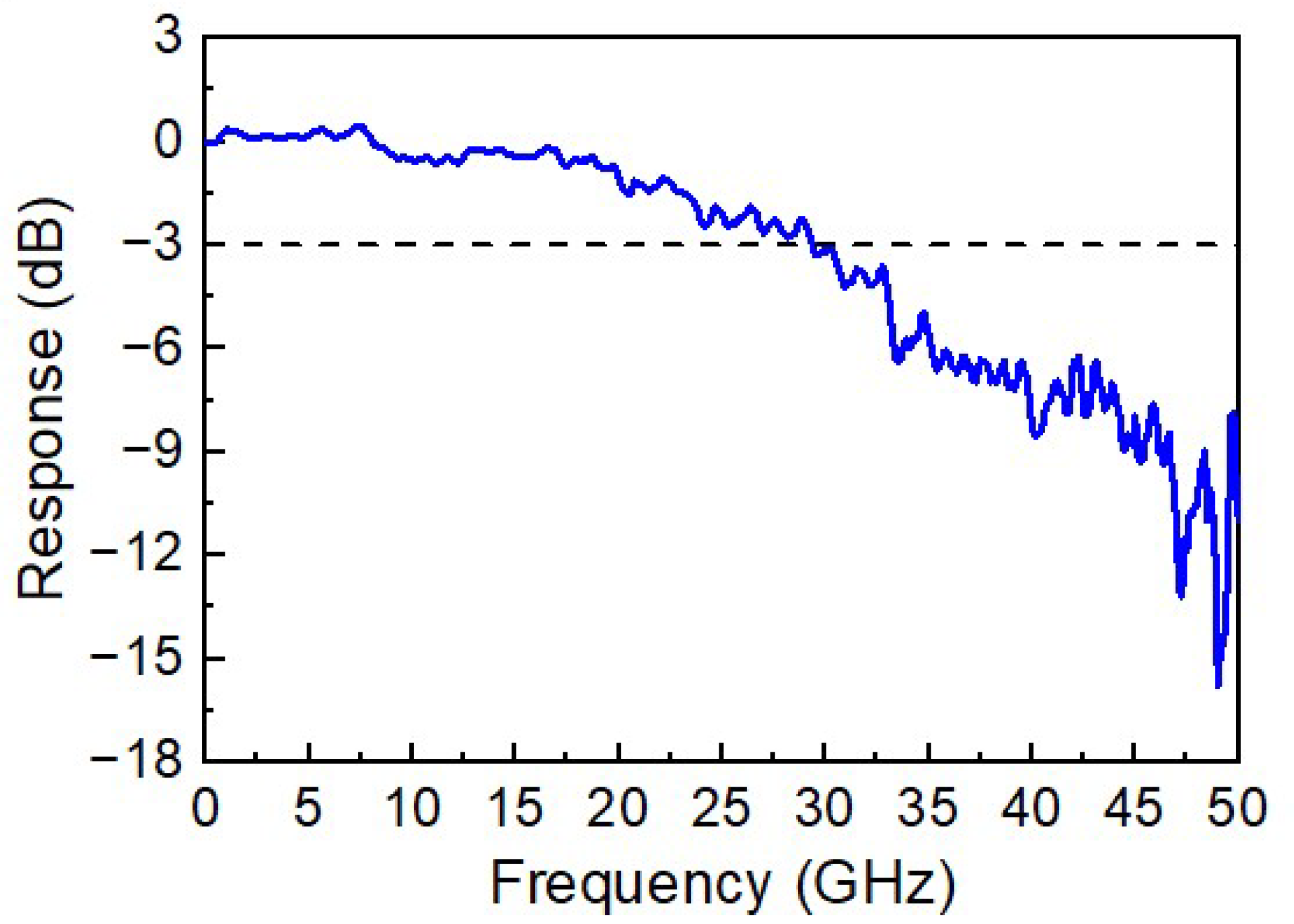

Publisher’s Note: MDPI stays neutral with regard to jurisdictional claims in published maps and institutional affiliations. |
© 2022 by the authors. Licensee MDPI, Basel, Switzerland. This article is an open access article distributed under the terms and conditions of the Creative Commons Attribution (CC BY) license (https://creativecommons.org/licenses/by/4.0/).
Share and Cite
Zhou, D.; Liang, S.; Zhang, R.; Yang, Q.; Zhu, X.; Lu, D.; Zhao, L.; Wang, W. 50 Gb/s Electro-Absorption Modulator Integrated with a Distributed Feedback Laser for Passive Optical Network Systems. Photonics 2022, 9, 780. https://doi.org/10.3390/photonics9100780
Zhou D, Liang S, Zhang R, Yang Q, Zhu X, Lu D, Zhao L, Wang W. 50 Gb/s Electro-Absorption Modulator Integrated with a Distributed Feedback Laser for Passive Optical Network Systems. Photonics. 2022; 9(10):780. https://doi.org/10.3390/photonics9100780
Chicago/Turabian StyleZhou, Daibing, Song Liang, Ruikang Zhang, Qiulu Yang, Xuyuan Zhu, Dan Lu, Lingjuan Zhao, and Wei Wang. 2022. "50 Gb/s Electro-Absorption Modulator Integrated with a Distributed Feedback Laser for Passive Optical Network Systems" Photonics 9, no. 10: 780. https://doi.org/10.3390/photonics9100780
APA StyleZhou, D., Liang, S., Zhang, R., Yang, Q., Zhu, X., Lu, D., Zhao, L., & Wang, W. (2022). 50 Gb/s Electro-Absorption Modulator Integrated with a Distributed Feedback Laser for Passive Optical Network Systems. Photonics, 9(10), 780. https://doi.org/10.3390/photonics9100780




